Structural insulated panels (SIPs) drastically speed up construction compared to stick-built methods. They allow enclosures in just 5-6 days, reducing overall timelines by up to 34%, saving hundreds of labor hours. Factory fabrication guarantees precise, ready-to-install panels, cutting onsite work and errors. This rapid approach shortens project durations, lowers costs, and boosts efficiency. To discover how SIPs compare in detail and how they can benefit your project, keep exploring these speed advantages.
Key Takeaways
- SIPs enable enclosure of a 2,000 sq ft home in just 5-6 days, significantly faster than traditional stick-built framing.
- Speed tests show SIPs reduce construction time by approximately 34% compared to stick-built methods.
- SIP panels are prefabricated with precise dimensions, allowing for quicker onsite assembly and fewer delays.
- Stick-built framing typically takes 19+ days for completion, while SIPs can be installed in a fraction of that time.
- Factory fabrication of SIPs minimizes weather-related delays and onsite labor, accelerating overall project timelines.
Overview of Construction Time Differences
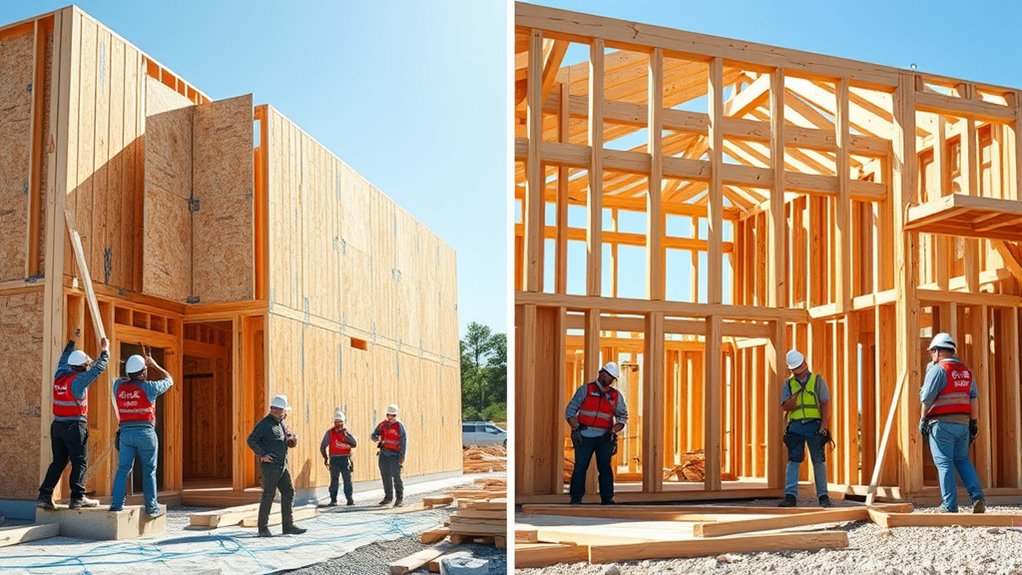
Construction time differences between Structural Insulated Panels (SIPs) and traditional stick-built methods are notable, with SIPs offering a faster overall process. Because SIPs come precut, insulated, and sheathed from the factory, you save time on framing, insulation, and vapor barrier installation. In contrast, stick-built construction involves multiple onsite steps—framing, installing batt insulation, sheathing, and vapor barriers—that extend the timeline. Factory-controlled conditions ensure precision, reducing onsite adjustments and corrections. SIPs roof, wall, and floor sections are ready to install immediately upon delivery, cutting days or even weeks from the project schedule. This streamlined process accelerates the entire build, enabling quicker enclosure and faster progression to interior work. Additionally, the color accuracy of factory-finished panels helps ensure consistent visual quality throughout the project, further reducing delays. Overall, SIPs considerably shorten construction durations compared to traditional methods.
On-Site Build Speed and Efficiency

You’ll notice that SIPs come together much faster on-site because they’re pre-cut and designed for quick assembly. This reduces the need for extensive on-site labor and allows multiple tasks, like site prep, to happen simultaneously. As a result, your project can move forward more efficiently and reach completion sooner. Incorporating rustic elements such as reclaimed wood accents and vintage-inspired fixtures can further enhance the quick, charming transformation of your space.
Faster Panel Assembly
Prefabricated SIPs are designed for quick on-site assembly, markedly reducing build time compared to traditional stick framing. Their precise manufacturing means panels arrive ready to install, with cutouts for windows and doors already included, eliminating on-site measuring and cutting. Because large panels integrate structure, sheathing, and insulation in one step, the number of components and connections needed decreases considerably. This streamlines the process, speeding up installation and reducing errors. A BASF study shows SIPs can cut construction timelines by up to 55%, thanks to fewer tasks like fitting and adjusting. Less lumber handling, waste, and on-site logistics further accelerate progress. Additionally, product consistency ensures each panel fits perfectly, contributing to faster construction. Overall, faster panel assembly means the building goes up more quickly, enabling earlier project completion and quicker access for other trades, boosting overall efficiency.
Reduced On-Site Labor
By streamlining the assembly process, SIPs considerably reduce the amount of on-site labor required. Since most of the work happens off-site during factory fabrication, you spend less time and effort on-site. The panels are pre-cut and ready for quick installation, which speeds up the entire process. You don’t need highly skilled labor, making workforce management easier and less costly. SIPs also dry-in faster, so other trades can start sooner, further accelerating your project timeline. This approach cuts overall construction time by up to 55%, reducing labor costs and minimizing site disruptions. With fewer workers needed on-site and less material waste, your project becomes more efficient, cost-effective, and less prone to delays caused by weather or errors. Familiar, century-old construction method reduces training time for workers and simplifies project management. Additionally, the standardized nature of SIPs enhances construction efficiency and quality control.
Simultaneous Site Prep
Pre-cut and precisely measured SIP panels enable simultaneous site preparation and panel installation, substantially speeding up the construction process. With ready-to-install large panels, you can coordinate foundation and utility work concurrently with off-site SIP fabrication, reducing overall project duration. Fewer components mean less on-site staging, clutter, and faster site access. SIPs streamline assembly by integrating structure, insulation, and sheathing in one step, cutting construction time by up to 55%. This approach shortens the critical path, allowing earlier weatherproofing and follow-on trades. Additionally, less waste generated from factory-cut panels creates a cleaner, safer site with easier material handling. Speeding up site prep and installation not only accelerates project timelines but also lowers costs, improves workflow, and minimizes weather-related delays, making your build more efficient and cost-effective. Cost savings are enhanced by the reduced labor and material handling required with SIPs, further increasing the overall efficiency of the project. Moreover, the integration of components in SIPs aligns with sustainability initiatives, promoting environmentally conscious construction practices.
Prefabrication and Factory Manufacturing Benefits
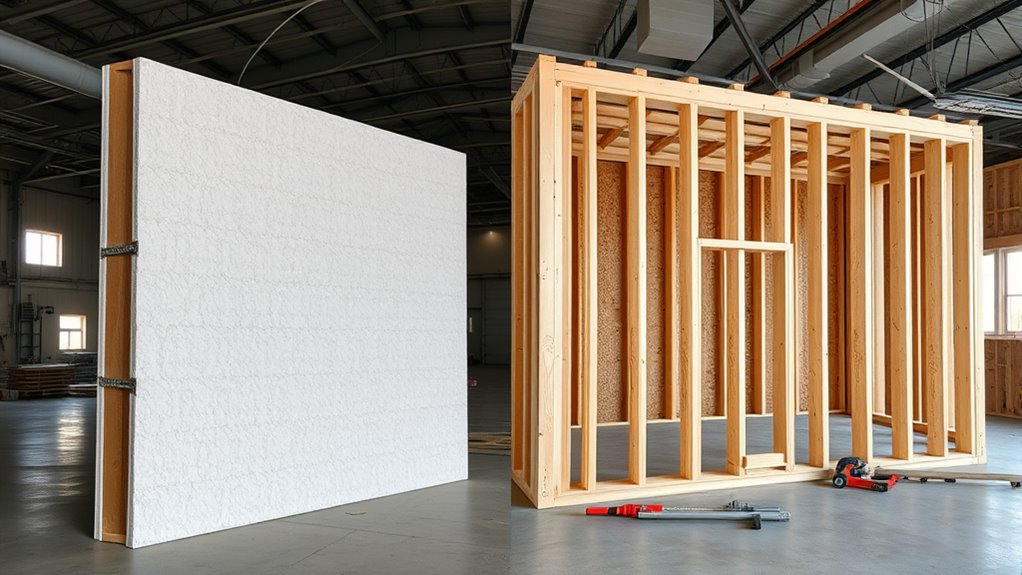
Prefabrication in a controlled factory setting speeds up the entire building process, allowing you to get your project done faster. With precision manufacturing, you’ll benefit from consistent quality and fewer errors compared to traditional on-site framing. This streamlined approach also helps guarantee tighter schedules and better overall control over the construction timeline. Moreover, factory fabrication of SIP panels ensures high-performance enclosures that are built to exact specifications, further enhancing project efficiency and durability. Additionally, risk mitigation is improved through controlled factory conditions, reducing the likelihood of on-site issues and delays.
Accelerated Production Process
The manufacturing of Structural Insulated Panels (SIPs) in controlled factory environments offers a considerable advantage over traditional stick-built methods by enabling an accelerated production process. In factories, panels are produced with exact precision, ensuring consistent dimensions and reducing errors. Prefabrication eliminates on-site measuring and cutting, speeding up assembly and lowering delays. Factory-made panels arrive ready to install, cutting overall construction time. Because of standardized quality and precise cuts, issues like warping or twisting are minimized. Installation can often be completed in days rather than weeks, reducing labor costs and weather-related risks. Additionally, factory fabrication optimizes material use, cutting waste by about 30%, and engineered wood reduces lumber waste markedly. This streamlined process allows for faster project completion and earlier occupancy, making SIPs a highly efficient building solution. Factory fabrication also enhances safety by reducing on-site construction hazards and minimizing worker exposure to adverse weather conditions.
Enhanced Quality Control
Manufacturing SIPs in controlled factory environments guarantees tight construction tolerances and high-precision manufacturing, which considerably improves overall quality. This process guarantees consistent dimensions and reduces errors, leading to fewer rework and lower labor costs. Your benefits include:
- Precise adherence to architectural plans, minimizing on-site adjustments.
- Fewer assembly errors due to strict quality control, increasing reliability.
- Airtight joints that enhance building envelope integrity, reducing drafts.
- Compliance with strict standards like ANSI/APA PRS 610.1-2023 and ICC-ES AC04, ensuring durability and code adherence.
- Controlled manufacturing environments also help in maintaining the environmental quality of the panels, ensuring they meet sustainability standards and reduce the risk of defects caused by external conditions. Additionally, consistent production helps in achieving better thermal performance, which is critical for energy efficiency.
These rigorous protocols result in panels that resist moisture, pests, and extreme loads better than traditional framing. Ultimately, factory-controlled production delivers a higher standard of quality, consistency, and performance for your building project.
Impact of SIPs on Construction Schedule Flexibility
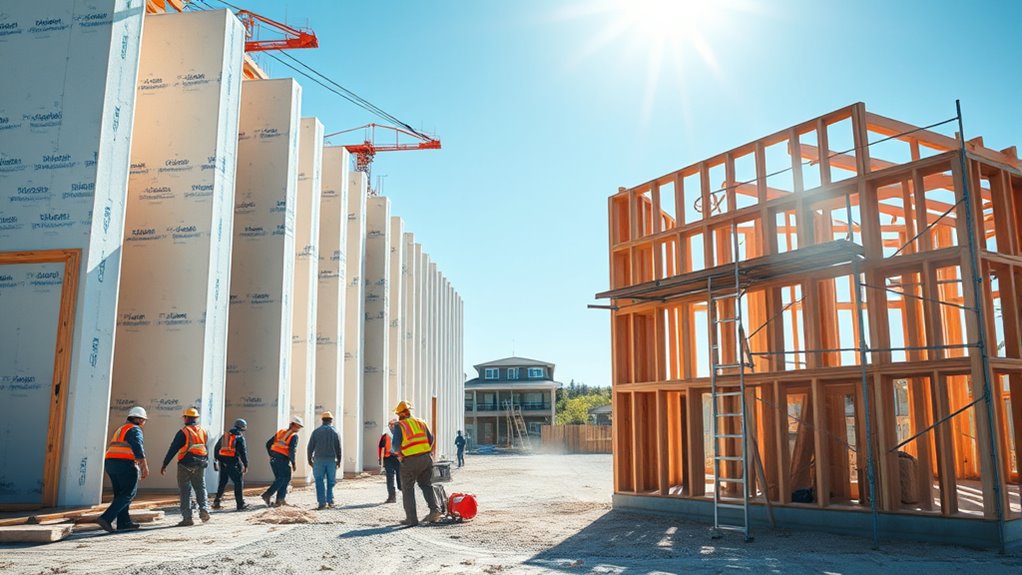
Using Structural Insulated Panels (SIPs) can substantially enhance construction schedule flexibility by streamlining on-site processes. Because SIPs are fabricated off-site and delivered pre-cut, you can enclose a 2,000 sq ft home in just 5-6 days, drastically reducing on-site construction time. Studies show SIPs require about 34% less time, saving around 161 labor hours per project. This quick assembly minimizes weather delays and mitigates labor shortages. Prefabrication reduces exposure to weather, making schedules more predictable and easier to manage. SIPs also accommodate complex designs, like vaulted ceilings and open plans, without extending timelines. With faster installation, you can start interior work sooner, improving task overlap and overall project control. This accelerated pace enhances your ability to meet deadlines and adapt to unforeseen delays. Faster construction also allows for earlier occupancy, which can improve project cash flow and reduce financing costs. Additionally, the prefabrication process enhances project predictability, helping stakeholders better plan resources and timelines.
Comparative Analysis of Labor Requirements
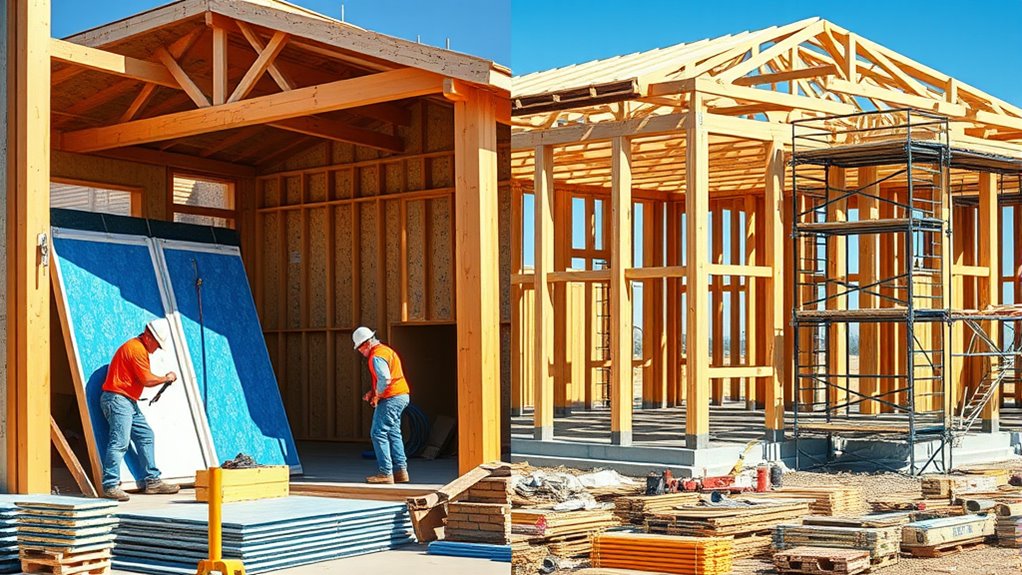
You’ll find that SIPs drastically cut on-site labor needs by prefabricating panels off-site, reducing the amount of work required during construction. This shift means less skilled labor is necessary on-site, speeding up the process and helping address labor shortages. As a result, the overall construction time decreases, allowing projects to finish faster and more efficiently. Maximize space and organization strategies can be integrated into panel design to further streamline construction and interior setup.
On-Site Labor Reduction
Have you ever considered how much on-site labor can be reduced with different construction methods? With SIPs, you’ll notice significant differences. 1. Fewer skilled workers are needed because much work is done in the factory. 2. Installation is faster due to large, prefabricated panels, reducing on-site assembly. 3. Construction time shortens, allowing trades to start sooner and speeding up project completion. 4. Reduced complexity minimizes errors and weather-related delays. Additionally, streamlined processes can help mitigate regulatory compliance challenges that often impact construction timelines. This means you spend less time coordinating workers, less on-site measuring and cutting, and fewer potential mistakes. SIPs streamline the process, making your project more efficient and cost-effective. The reduced labor requirements not only save money but also help mitigate skilled labor shortages, keeping your project on schedule.
Factory vs. Site Work
Factory fabrication of SIPs substantially reduces on-site labor by enabling precise cutting, customization, and quality control in a controlled environment. This process minimizes on-site modifications and errors, speeding up construction. Factory-controlled conditions eliminate weather delays and inefficiencies common in site framing, while simultaneous production of wall, roof, and floor panels accelerates project timelines. Quality control in the factory reduces rework, lowering labor costs. Factory labor benefits from mechanization and optimized assembly lines, which aren’t possible on-site. In contrast, site work for SIPs involves panel positioning and fastening, requiring specialized equipment like cranes and lift trucks, and skilled crews. Stick-built framing demands more skilled carpenters for measuring, cutting, and fitting lumber, increasing labor hours. Overall, factory work streamlines the process, reducing labor time and costs considerably. Use of SIP panels can cut framing labor needs by up to 55% (BASF study).
How SIPs Reduce Construction Timeline by Up to 55
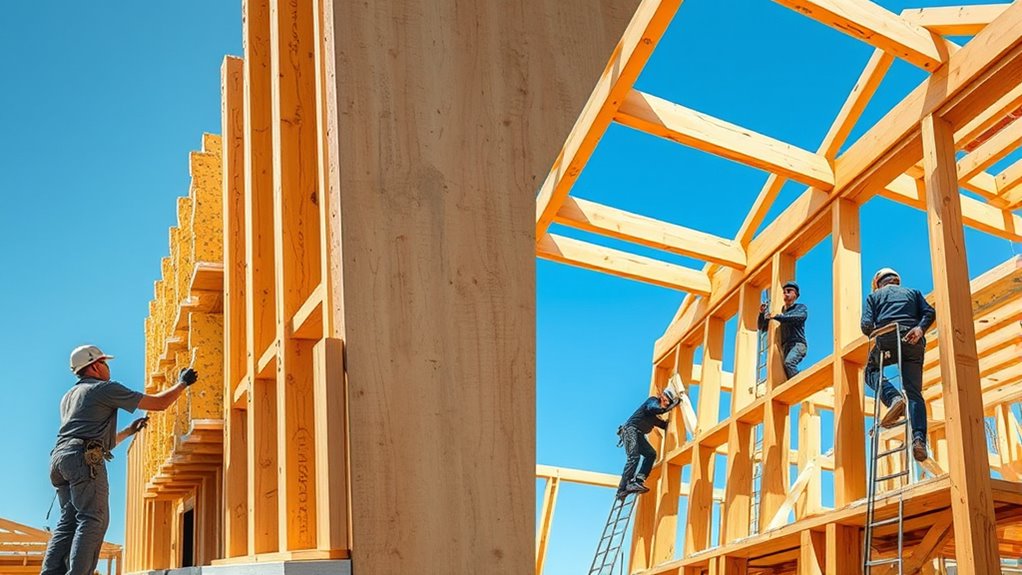
Prefabricated Structural Insulated Panels (SIPs) considerably cut down construction timelines by streamlining the building process. Their off-site manufacturing allows you to skip many on-site tasks, speeding up overall progress. With simplified assembly, each panel fits seamlessly, reducing adjustments and rework. Fewer workers are needed because of the ease of installation, saving time and resources. Additionally, SIPs’ weather-resistant qualities prevent delays caused by bad weather, enabling work to continue uninterrupted. These factors combine to make SIP construction up to 55% faster than traditional methods. Specifically:
- Prefabrication minimizes on-site fabrication time.
- Seamless panels shorten assembly duration.
- Less labor reduces scheduling complexities.
- Weather resistance keeps construction on track regardless of climate.
Cost Savings Associated With Faster Construction

Faster construction times with SIPs lead directly to significant cost savings across multiple areas. You’ll see reduced labor costs, as SIPs cut framing labor-hours by up to 66%, streamlining installation and decreasing the need for multiple trades. Prefabrication speeds up assembly, while a uniform nailing surface accelerates siding and trim work, further lowering labor inputs. Less time on site means lower equipment rental and site overhead expenses, including utilities and security. Additionally, SIPs minimize material waste through precise factory cuts, reducing disposal costs and extending material reuse. The shorter build schedule also limits exposure to weather delays and reduces financing costs. Research indicates that using SIPs can lead to savings of 55% to 66% in framing labor-hours for residential projects. Overall, these efficiencies translate into a more affordable project, with lower labor, material, and overhead expenses, enhancing your bottom line from start to finish.
The Role of SIPs in Shortening Financing and Holding Costs
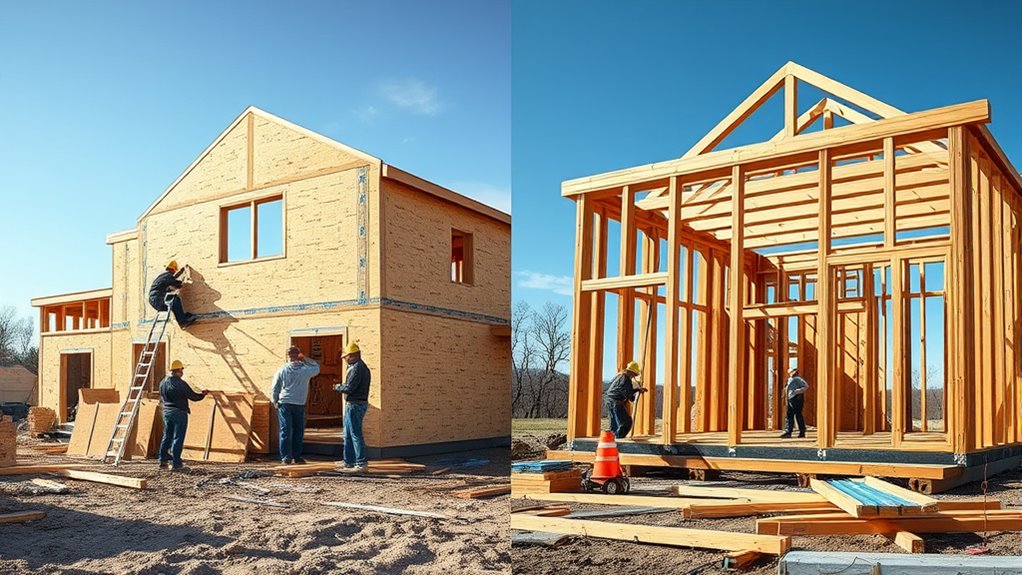
By considerably reducing construction timelines, SIPs enable you to complete projects more quickly, which directly shortens the period that lenders need to finance the build. This leads to lower interest and holding costs, freeing up capital sooner. Faster project completion reduces risks from weather delays and labor shortages, making your project less risky for lenders. Additionally, financial institutions often view SIP projects as lower risk, potentially offering better loan terms. To maximize these benefits:
- Shorter timelines reduce financing duration.
- Quicker enclosure speeds up subsequent trades.
- Lower risk of weather damage cuts costs.
- Faster completion enhances cash flow and investment returns.
Factory-built panels with insulating foam core provide consistent quality and precise construction, further supporting faster and more reliable project timelines.
Case Studies Highlighting Speed Advantages
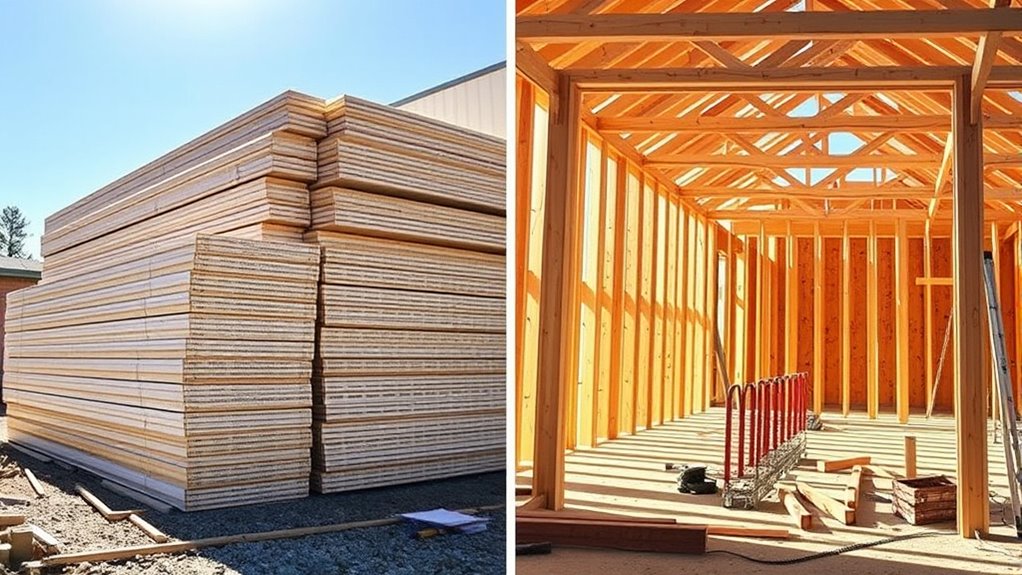
Numerous case studies demonstrate how SIP technology accelerates construction timelines. Factory-cut panels with precise dimensions, including openings, notably reduce onsite modifications, enabling faster assembly. Pre-cut connections and panel pockets streamline installation, while factory tooling minimizes errors and rework. In practice, a four-person crew can set 100 linear feet of walls in less than three hours using pre-cut SIPs. Labor efficiency is also evident; SIP installation averages 8.33 lineal feet per man hour, outperforming traditional methods. Projects report framing completion in as little as 19 days, allowing earlier enclosure and interior work. Additionally, SIPs generate less waste, speeding cleanup and reducing delays. Early planning and detailed shop drawings further enhance workflow, making SIPs a clear choice for rapid, efficient construction. Research indicates that SIPs can reduce overall construction time by up to 50%, making them an increasingly popular option for fast-paced projects.
Long-Term Benefits of Rapid Construction Cycles
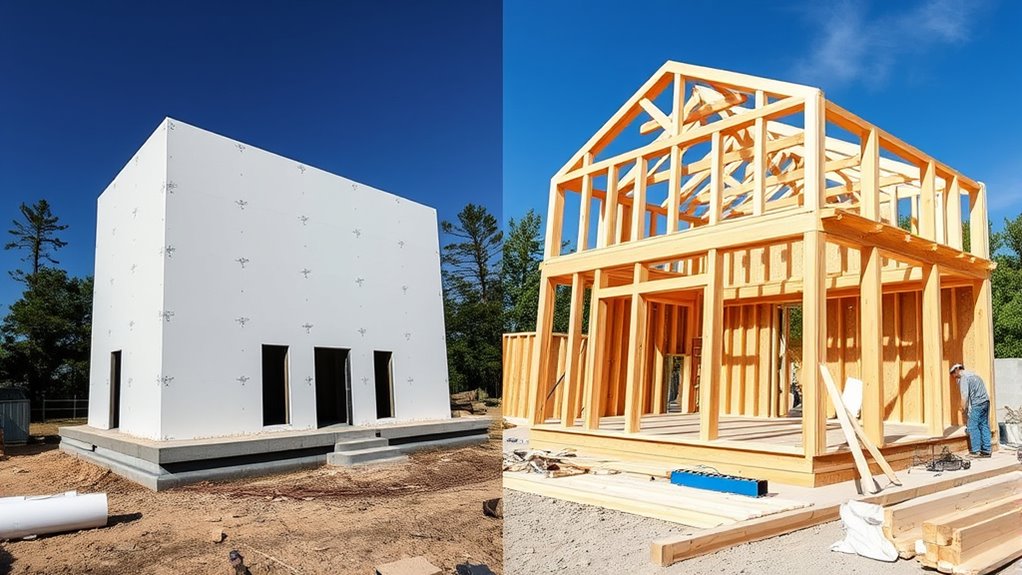
Implementing rapid construction cycles delivers long-term benefits that extend beyond initial project completion. You’ll see improvements like:
- Enhanced durability—quality standards remain consistent, ensuring buildings last longer.
- Lower maintenance costs—well-designed structures reduce the need for frequent repairs.
- Reduced lifecycle expenses—faster projects minimize ongoing operational and repair costs.
- Sustainable growth—lean methods support eco-friendly practices and help meet net-zero goals.
These advantages mean your investments pay off over time, with buildings that are durable, cost-effective, and environmentally responsible. By embracing rapid construction, you’re not just saving time initially; you’re setting the stage for long-term success, minimized costs, and sustainable development. Addressing productivity stagnation is essential to achieving these long-term benefits, as it allows the industry to deliver projects more efficiently and meet rising global demand.
Frequently Asked Questions
How Do SIPS Impact Overall Project Scheduling and Deadlines?
You’ll find that using SIPs considerably improves your project schedule and deadlines. They speed up construction by reducing labor hours and enabling faster enclosure, which means you can start subsequent phases sooner. This approach shortens cycle times, minimizes weather delays, and allows for simultaneous site development. Overall, SIPs help you meet or beat deadlines, cut costs, and keep your project on track for earlier completion.
Are There Any Limitations to Using SIPS in Certain Climate Zones?
You should know that using SIPs in certain climate zones does come with limitations. In very cold or humid areas, you need to guarantee proper vapor management and airtight sealing to prevent moisture issues. Additionally, in high fire-risk zones, SIPs may require special fire-resistant treatments or claddings. Seismic zones might demand extra structural evaluations. So, adapt your design and installation practices accordingly to assure maximum performance in your specific climate.
What Quality Control Measures Ensure SIP Panels Meet Construction Standards?
Imagine a project where SIP panels are tested in a lab, and you see the rigorous quality controls in action. To guarantee they meet standards, manufacturers conduct strict pull tests, check foam density, and adhere to ANSI/APA and ICC standards. Regular third-party audits verify compliance, while precise tolerances and consistent materials maintain performance. These measures guarantee your SIP panels are reliable, durable, and up to code for your construction needs.
How Do SIPS Influence the Availability of Skilled Labor During Construction?
You’ll find that SIPs positively impact skilled labor availability during construction. They need fewer workers because panels come pre-assembled, reducing the number of trades required. With less reliance on multiple skilled trades, you can guarantee labor shortages. Plus, training crews in SIP-specific techniques ensures proper installation, making your project more efficient. This streamlined approach helps you finish faster, saves costs, and lessens the pressure on scarce skilled labor resources.
Can SIPS Be Integrated With Traditional Building Methods for Hybrid Projects?
You’ll find that SIPs integrate well with traditional building methods in hybrid projects, boosting efficiency. In fact, combining SIPs with stick framing can cut construction time by up to 50%. You need to carefully coordinate design and installation, ensuring proper sealing and alignment. Skilled teams are essential, but with proper planning, SIPs can enhance insulation, structural strength, and flexibility, making your project faster, more energy-efficient, and cost-effective.
Conclusion
When you choose structural insulated panels, you might find yourself sipping coffee in your new home sooner than expected. The speed of installation could turn your dream project into a reality faster, saving you time and money. As you watch walls rise swiftly and schedules tighten, you’ll realize that quick construction isn’t just about saving days—it’s about creating your space with less hassle and more confidence. Sometimes, the fastest path truly leads to the best outcome.
I’m Theodore, and I love tiny houses. In fact, I’m the author of Tiny House 43, a book about tiny houses that are also tree houses. I think they’re magical places where imaginations can run wild and adventures are just waiting to happen.
While tree houses are often associated with childhood, they can be the perfect adult retreat. They offer a cozy space to relax and unwind, surrounded by nature. And since they’re typically built on stilts or raised platforms, they offer stunning views that traditional homes simply can’t match.
If you’re looking for a unique and romantic getaway, a tree house tiny house might just be the perfect option.










